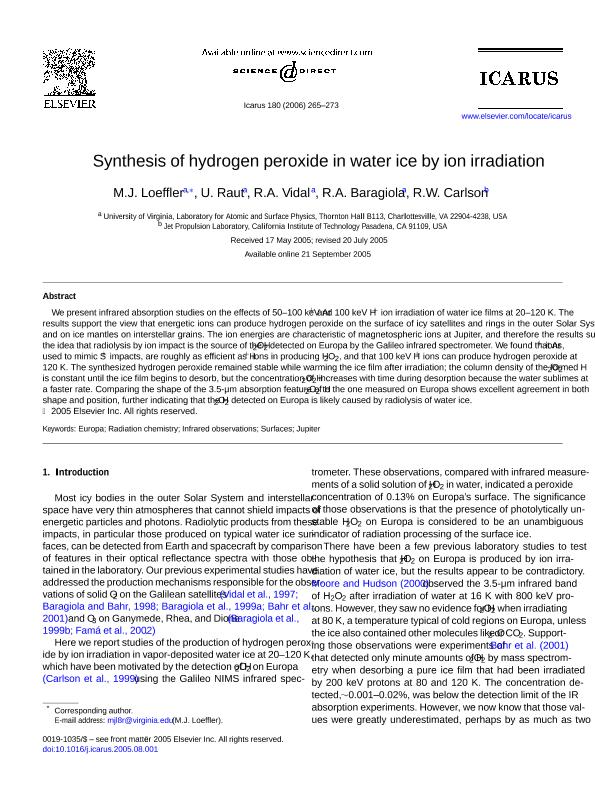Mostrar el registro sencillo del ítem
dc.contributor.author
Loeffler, M. J.
dc.contributor.author
Raut, U.
dc.contributor.author
Vidal, Ricardo Alberto

dc.contributor.author
Baragiola, R. A.
dc.contributor.author
Carlson, R. W.
dc.date.available
2017-07-27T16:28:55Z
dc.date.issued
2006-12
dc.identifier.citation
Loeffler, M. J.; Raut, U.; Vidal, Ricardo Alberto; Baragiola, R. A.; Carlson, R. W.; Synthesis of hydrogen peroxide in water ice by ion irradiation; Academic Press Inc Elsevier Science; Icarus; 180; 1; 12-2006; 265-273
dc.identifier.issn
0019-1035
dc.identifier.uri
http://hdl.handle.net/11336/21459
dc.description.abstract
We present infrared absorption studies on the effects of 50–100 keV Ar+ and 100 keV H+ ion irradiation of water ice films at 20–120 K. The results support the view that energetic ions can produce hydrogen peroxide on the surface of icy satellites and rings in the outer Solar System, and on ice mantles on interstellar grains. The ion energies are characteristic of magnetospheric ions at Jupiter, and therefore the results support the idea that radiolysis by ion impact is the source of the H2O2 detected on Europa by the Galileo infrared spectrometer. We found that Ar+ ions, used to mimic S+ impacts, are roughly as efficient as H+ ions in producing H2O2, and that 100 keV H+ ions can produce hydrogen peroxide at 120 K. The synthesized hydrogen peroxide remained stable while warming the ice film after irradiation; the column density of the formed H2O2 is constant until the ice film begins to desorb, but the concentration of H2O2 increases with time during desorption because the water sublimes at a faster rate. Comparing the shape of the 3.5-µm absorption feature of H2O2 to the one measured on Europa shows excellent agreement in both shape and position, further indicating that the H2O2 detected on Europa is likely caused by radiolysis of water ice.
dc.format
application/pdf
dc.language.iso
eng
dc.publisher
Academic Press Inc Elsevier Science

dc.rights
info:eu-repo/semantics/openAccess
dc.rights.uri
https://creativecommons.org/licenses/by-nc-sa/2.5/ar/
dc.subject.classification
Física de los Materiales Condensados

dc.subject.classification
Ciencias Físicas

dc.subject.classification
CIENCIAS NATURALES Y EXACTAS

dc.title
Synthesis of hydrogen peroxide in water ice by ion irradiation
dc.type
info:eu-repo/semantics/article
dc.type
info:ar-repo/semantics/artículo
dc.type
info:eu-repo/semantics/publishedVersion
dc.date.updated
2017-07-26T15:23:36Z
dc.journal.volume
180
dc.journal.number
1
dc.journal.pagination
265-273
dc.journal.pais
Países Bajos

dc.journal.ciudad
Amsterdam
dc.description.fil
Fil: Loeffler, M. J.. University of Virginia; Estados Unidos
dc.description.fil
Fil: Raut, U.. University of Virginia; Estados Unidos
dc.description.fil
Fil: Vidal, Ricardo Alberto. Consejo Nacional de Investigaciones Científicas y Técnicas. Centro Científico Tecnológico Conicet - Santa Fe. Instituto de Desarrollo Tecnológico para la Industria Química. Universidad Nacional del Litoral. Instituto de Desarrollo Tecnológico para la Industria Química; Argentina
dc.description.fil
Fil: Baragiola, R. A.. University of Virginia; Estados Unidos
dc.description.fil
Fil: Carlson, R. W.. California Institute of Technology Pasadena; Estados Unidos
dc.journal.title
Icarus

dc.relation.alternativeid
info:eu-repo/semantics/altIdentifier/doi/http://dx.doi.org/10.1016/j.icarus.2005.08.001
dc.relation.alternativeid
info:eu-repo/semantics/altIdentifier/url/http://www.sciencedirect.com/science/article/pii/S0019103505002848
Archivos asociados
